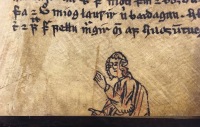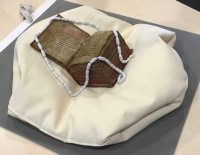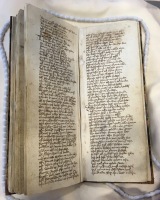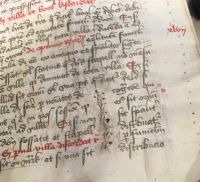Scandinavian manuscript summer course!
Aug. 26th, 2017 10:48 pmAs I briefly mentioned in my last post, this summer I participated in a summer school in Scandinavian manuscript studies at Copenhagen University. The course is organised by the Arnamagnæan Institute at Copenhagen University and the Árni Magnússon Institute for Icelandic Studies in Reykjavik, and it alternates between Copenhagen and Reykjavik.
There are three levels: basic, advanced and master. Basic gives you a good grounding in Scandinavian manuscript production, palaeography (i.e. handwriting style) for both Icelandic and Danish/Swedish, including all the abbreviations*, how to describe and interpret illuminations in a manuscript, Medieval Danish and Swedish language (there were no classes in Medieval Icelandic, since basic knowledge of Medieval Icelandic was in the course requirements**), as well as more specialised topics such as how to use change in language/grammar and palaeography to date Icelandic manuscripts, the use of runes in manuscripts, and post-medieval Icelandic palaeography.
*: Since parchment was very expensive in Iceland, they used abbreviations a lot, both to shorten the time spent writing and the amount of parchment needed for a text. In some cases almost 70% of the words on a page are abbreviated!
**: I was given an exception for this. There were some classes where you definitely needed a working knowledge of Icelandic, but most were fine without it.

A little man in the margin of the Kings' Saga (AM81fol, fol.95r, 16th century). Click to embiggen.
The advance class focussed more on the text; how to transcribe medieval texts properly including how to code for the abbreviations in the most "academic" of transcription styles. Most texts in ordinary transcribed books are transcribed more loosely, either by marking all abbreviations in italics (but not showing what the abbreviation signs looked like), or for a more popular publication, just typing the text as it was intended to be read (assuming that the editor has interpreted the abbreviations correctly...).

This tiny lawbook (10x8cm!) contains King Valdemar's law for Sjælland. (AM455 12mo, fol.4v-5r, 1275-1325). Click to embiggen and read the famous first line "Meth lagh scal land byggæs" (with law shall land be built).
The master class is for the select few who have taken both classes before and who really want to dive into manuscript analysis. This year they worked on a late medieval text on Virgin Mary legends, transcribing them in various ways. I really liked that their work was not just considered an exercise, but that it will be put online for other researchers to use.

Collection of prose. Tall rectangular format so there won't be unnecessary blank space when you write short rhyming lines (AM191fol, fol.83v, late 15th century). Click to embiggen.
We had two excursions: one to Roskilde for the cathedral and the Viking ship museum and then to Gammel-Lejre, a pre-Viking Age high status site, which some people think is the location for Beowulf.
The second excursion was part of the runes-day: we had a guided tour of several rune-related persons and tombstones at Assistens cemetery in the centre of Copenhagen.

The whole class at the stone setting/burial area at Gammel Lejre. The museum is one of the buildings in the background. Click to embiggen.
It was a really interesting course. I particularly liked that we had so many opportunities to see and handle manuscripts (thirteen workshops, six with manuscripts). You get an entirely different feel for the books than when you only see them on a computer screen. Not that I don't appreciate the ongoing digitization of manuscripts - it's such a help for knowledge gathering in all sorts of ways. If you want to see the manuscripts we worked on, they are online at Handrit.is. It was a very mixed bunch of people: mostly from a "medieval studies" background - I think I was the only archaeologist - and from all over: Denmark, Norway, Faroe Islands, Poland, Czech republic, Germany, Britain, USA, and probably more places too. I surprised a fair few of my classmates (the not-Danes) when they found out I didn't rent a place in Copenhagen for the course, but commuted each day from Sweden. But the South Campus is very convenient for the metro, so it took just about an hour door to door. Definitely worth it!

Darned parchment from AM37 4to, 15th/16th century. Click to embiggen.
There are three levels: basic, advanced and master. Basic gives you a good grounding in Scandinavian manuscript production, palaeography (i.e. handwriting style) for both Icelandic and Danish/Swedish, including all the abbreviations*, how to describe and interpret illuminations in a manuscript, Medieval Danish and Swedish language (there were no classes in Medieval Icelandic, since basic knowledge of Medieval Icelandic was in the course requirements**), as well as more specialised topics such as how to use change in language/grammar and palaeography to date Icelandic manuscripts, the use of runes in manuscripts, and post-medieval Icelandic palaeography.
*: Since parchment was very expensive in Iceland, they used abbreviations a lot, both to shorten the time spent writing and the amount of parchment needed for a text. In some cases almost 70% of the words on a page are abbreviated!
**: I was given an exception for this. There were some classes where you definitely needed a working knowledge of Icelandic, but most were fine without it.

A little man in the margin of the Kings' Saga (AM81fol, fol.95r, 16th century). Click to embiggen.
The advance class focussed more on the text; how to transcribe medieval texts properly including how to code for the abbreviations in the most "academic" of transcription styles. Most texts in ordinary transcribed books are transcribed more loosely, either by marking all abbreviations in italics (but not showing what the abbreviation signs looked like), or for a more popular publication, just typing the text as it was intended to be read (assuming that the editor has interpreted the abbreviations correctly...).

This tiny lawbook (10x8cm!) contains King Valdemar's law for Sjælland. (AM455 12mo, fol.4v-5r, 1275-1325). Click to embiggen and read the famous first line "Meth lagh scal land byggæs" (with law shall land be built).
The master class is for the select few who have taken both classes before and who really want to dive into manuscript analysis. This year they worked on a late medieval text on Virgin Mary legends, transcribing them in various ways. I really liked that their work was not just considered an exercise, but that it will be put online for other researchers to use.

Collection of prose. Tall rectangular format so there won't be unnecessary blank space when you write short rhyming lines (AM191fol, fol.83v, late 15th century). Click to embiggen.
We had two excursions: one to Roskilde for the cathedral and the Viking ship museum and then to Gammel-Lejre, a pre-Viking Age high status site, which some people think is the location for Beowulf.
The second excursion was part of the runes-day: we had a guided tour of several rune-related persons and tombstones at Assistens cemetery in the centre of Copenhagen.

The whole class at the stone setting/burial area at Gammel Lejre. The museum is one of the buildings in the background. Click to embiggen.
It was a really interesting course. I particularly liked that we had so many opportunities to see and handle manuscripts (thirteen workshops, six with manuscripts). You get an entirely different feel for the books than when you only see them on a computer screen. Not that I don't appreciate the ongoing digitization of manuscripts - it's such a help for knowledge gathering in all sorts of ways. If you want to see the manuscripts we worked on, they are online at Handrit.is. It was a very mixed bunch of people: mostly from a "medieval studies" background - I think I was the only archaeologist - and from all over: Denmark, Norway, Faroe Islands, Poland, Czech republic, Germany, Britain, USA, and probably more places too. I surprised a fair few of my classmates (the not-Danes) when they found out I didn't rent a place in Copenhagen for the course, but commuted each day from Sweden. But the South Campus is very convenient for the metro, so it took just about an hour door to door. Definitely worth it!

Darned parchment from AM37 4to, 15th/16th century. Click to embiggen.